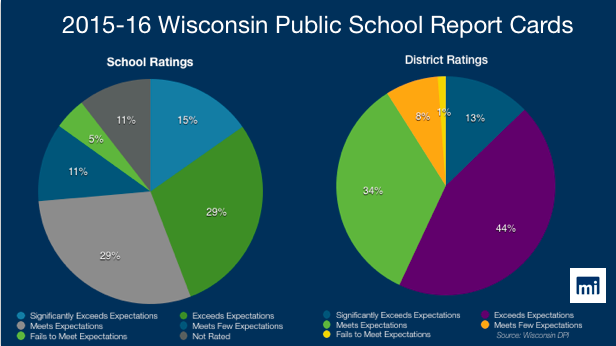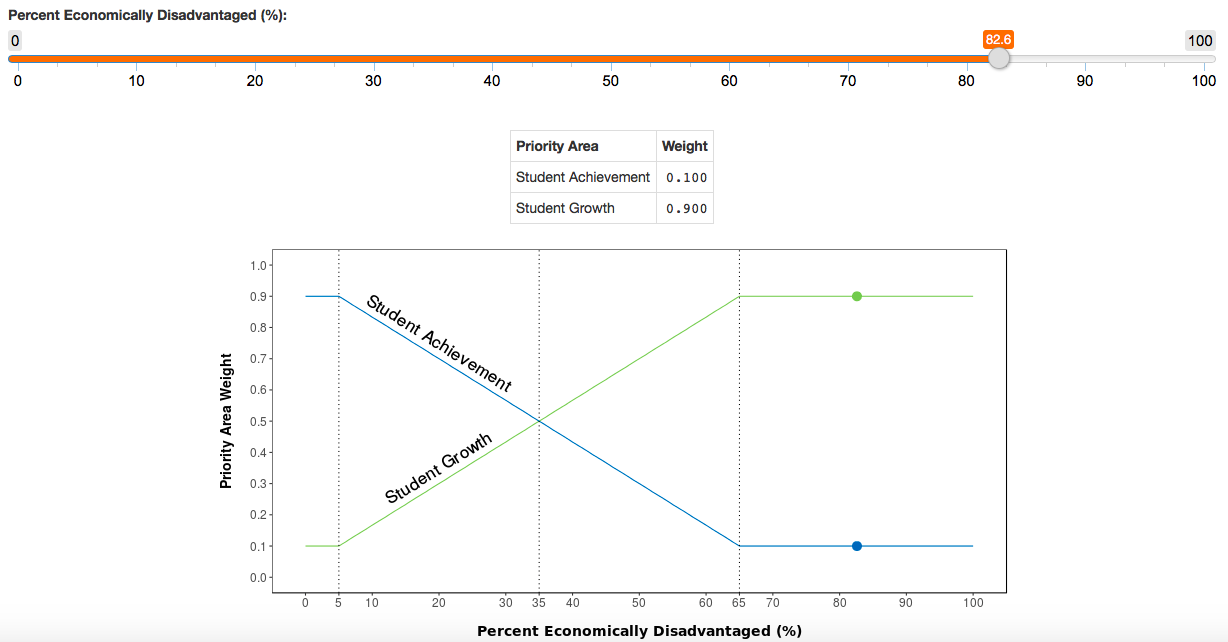
Nearly 10,000 students in Racine attend failing schools, while 25,000 students face the same reality within Milwaukee
November 21, 2016
By Ola Lisowski
MacIver Institute Research Associate
[Madison, Wis…] Wisconsin’s Department of Public Instruction released new report cards for the state’s public schools, and some of the results have the public puzzled. The big news of the release was, as most expected, that Milwaukee Public Schools (MPS) fell off the list of failing school districts while five others took its place.
This is not a small problem or just a few kids – there are 9,605 kids in Racine and 24,447 kids in Milwaukee who attend failing schools.
Racine Unified School District (RUSD) was categorized as failing to meet expectations with a score of 48.1 of 100. Eleven RUSD schools – 34.4 percent of the district – failed to meet expectations. That’s slightly higher than Milwaukee’s 27.6 percent of failing schools. However, at just shy of 10,000 students, the number of kids enrolled in failing schools at RUSD is much smaller than at MPS, where nearly 25,000 students attend failing schools. That should speak volumes to the size and scope of the issues these districts face.
The new report cards feature five key priority areas: student achievement, student growth, closing gaps, and on-track and postsecondary readiness. RUSD students outscored MPS students in three of these four metrics by an average margin of just over five out of 100 points. In the student growth category, however, RUSD students scored only a 26.1 compared to MPS’ 60.3.
RUSD also didn’t receive any deductions in the “student engagement indicators” category, which penalizes districts for low test participation, high absenteeism, and high dropout rates. MPS was penalized five points for an absentee rate of 21.1 percent, higher than DPI’s 13 percent or lower goal.
As such, the numbers reveal that it was mainly a lack of year-over-year growth that put RUSD in the failing category while MPS skated by.

Meanwhile, recent data such as the University of Wisconsin System’s Report on Remedial Education and Forward and ACT Exam results shine a light on the reality within Wisconsin’s schools. The remedial education report revealed that 175 public high schools in Wisconsin sent more than six graduates into the UW System that ended up having to take remedial classes. Of the schools included in the report, 160 graduated classes where more than 10 percent of students needed remediation once arriving at UW.
Thirteen MPS institutions made the remedial education report – five RUSD schools did the same. In both districts, high
percentages of graduates needed remediation. At the five RUSD schools on the report, an average of 33 percent of graduates needed remediation upon entry at UW. At the MPS schools, the average was 56 percent.

To understand the potential disparities between the state’s report cards and recent data, one must examine the report card’s new criteria.
The new report cards weigh student achievement and student growth differently based on the overall percentage of economically disadvantaged students within the district. The thinking here is that high levels of poverty tend to affect how well students fare in the classroom. While this argument itself is a source of controversy, most will agree that high levels of poverty – at minimum – introduce different kinds of challenges into the classroom.
Take MPS, where a clear majority – 82.6 percent of students – are economically disadvantaged. In the new report cards, student growth is weighted at 0.90 while achievement is weighted only 0.10. On the other hand, consider MPS’ neighbors to the north at Mequon-Thiensville, where only 9.0 percent of students are economically disadvantaged. In that district, student growth is weighted only 0.153 while student achievement is weighted 0.847.

At RUSD, 59.9 percent of students are economically disadvantaged. As a result, student achievement is weighted only 0.168 while growth is weighted 0.832, putting RUSD not far away from MPS on the sliding scale.
Why is this? In implementing a sliding scale, DPI is attempting to consider the impact of poverty on student achievement. Even if a student is still faring poorly or perhaps has not achieved proficiency in English or math, it’s important to at least consider if that student has improved over time. Of course, the ultimate goal is proficiency in every subject – but by considering growth more heavily, DPI can examine if kids are making slight improvements.
At least, that’s the hope. Assembly Committee on Education Chair Rep. Jeremy Thiesfeldt (R-Fond du Lac) said that the legislature “wanted to give Milwaukee schools an opportunity to show through these report cards that there is some improvement taking place.”
The real question is whether or not there is actual, meaningful improvements taking place within MPS. On the last report cards, issued in 2014, MPS was the only district of 424 in the state that was failing to meet expectations. Today, MPS is officially meeting few expectations, just 2.4/100 points away from the “failing” category. In their official press release, MPS seemed to declare victory.
“We believe these report cards better reflect the performance in our schools,” Darienne Driver, MPS Superintendent, said. “We still have significant work to do, but we are headed in the right direction. I am proud of the hard work of our students, teachers, staff, and families. We are seeing growth in student achievement and closing the academic gap.”
When one considers the numbers, it seems not much has changed within the district despite the fact that it’s no longer labeled as failing. Nearly 25,000 students attend the 42 failing schools within MPS. Two years ago, about 28,000 students attended 47 failing schools. Joint Finance Committee co-chair Sen. Alberta Darling (R-River Hills) emphasized this point in her remarks.
“I’m encouraged by the progress made in the Milwaukee Public Schools under the leadership of Dr. Darienne Driver. However, the report cards also show that nearly 25,000 kids are still trapped in failing schools. That’s a larger population than the cities of Watertown, Mequon, or South Milwaukee,” Darling said. “I will continue to work on ways to make sure every child has the opportunity to attend a great school. Parents and children in MPS shouldn’t be forced to wait any longer.”
Ultimately, despite official labels, it seems schools and districts across the state have work to do.
“People look at the report cards as though digging into the data,” Rep. Thiesfeldt said. “They would say, oh wow, there’s been this big improvement in Milwaukee Public Schools because there aren’t nearly as many failing, the district is no longer considered failing. But if you dig into the data, you find that really probably not a lot has changed other than the way that it scored. In terms of there being big-time improvements in Milwaukee, no, I don’t think that has occurred.”
This story will be updated as further reactions are released.




